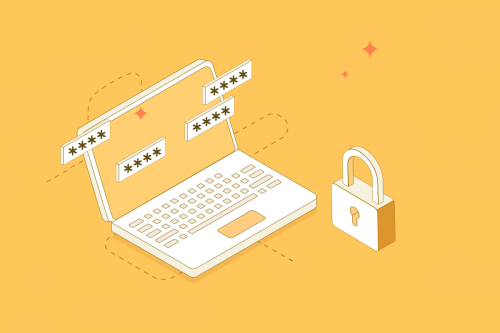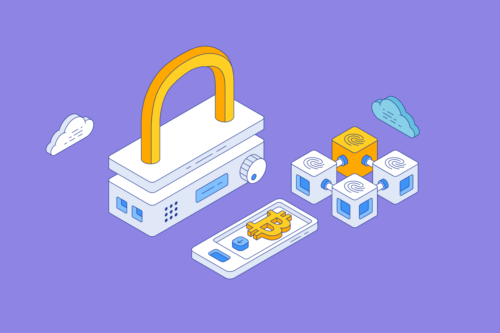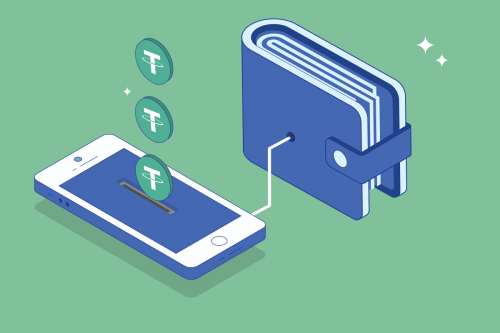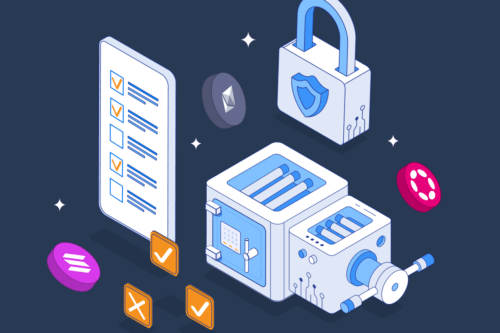Imagine you just bought some gold. You would want to keep it in a very secure place, like a safety deposit box for instance. You should treat your crypto assets exactly the same. This guide will explain how to secure cryptocurrency. It will look at the different types of cryptocurrency wallets and explore the different techniques you can use to secure your crypto assets.
How is cryptocurrency stored?
Cryptocurrencies are stored in crypto wallets. A crypto wallet is similar to a bank account in many ways. You can store your money there, use it to pay for goods and services, and withdraw money whenever you like.
The basics of crypto wallets
Types of crypto wallet
There are two main types of wallets: hot wallets and cold wallets. A hot wallet is connected to the internet and allows the user quick and convenient access to their digital assets. The most frequently used hot wallets are those found on cryptocurrency exchanges. A cold wallet is isolated from the internet. The most common type of cold wallet is a hardware wallet, such as a Ledger or a Trezor.
Keys
There are two types of keys: public keys and private keys. A public key allows you to receive cryptocurrency transactions, but nothing more. A private key “unlocks” your digital wallet and will allow you to transfer or spend your funds. This is why private keys should never be shared with anyone. They are the codes to keep your crypto safe. A private key can be represented in a number of ways, for example:
- A string of 256 ones and zeroes
- A QR code
- A 64-digit hexadecimal number i.e E9873H79C6D87DC0FB6A5778633389F4453213303DA61F20BD67FC233AA33263
Seed phrase
A seed phrase is a sequence of random words generated by your cryptocurrency wallet that allows you to access that wallet (often it is used in case you forget your password or private keys). A seed phrase is generally 12-24 words long and might look something like this: Sickle Poker Stockade Synapsis Inanity Stoup Secret Ape Clumsy Clank Resolved Towel
This seed phrase is generally written down on a piece of paper and stored in a secure location, such as a safety deposit box.
Did You Know?
Some crypto enthusiasts etch their seed phrase into a piece of metal, which they then bury or lock away. The benefit of metal is that it protects against things like water and fire damage.
Choosing a secure and trustworthy exchange
One of the best ways to avoid cryptocurrency scams is to use exchanges that are secure and trustworthy. A good exchange will offer a range of security options and excellent customer support in the event that you need help with something. A reputable exchange will also have a high score on community review websites, such as Trustpilot.
There are a number of exchanges that meet these criteria. For instance, Swyftx is a popular exchange within Australia and New Zealand where people can quickly and securely trade crypto, with access to world-class customer support.
Securing your exchange wallet
Hot wallet management
Exchange wallets and digital wallets (Metamask) are hot wallets as they have an established connection to the internet. This internet connection makes hot wallets inherently less secure than cold wallets. Having a large sum of crypto in one place can be risky. It may be worth transferring them to a cold wallet or distributing them across multiple wallets. Users planning on using a hot wallet for making payments or transactions should consider topping up a small amount when it falls below a threshold.
Did You Know
On August 2022, over 9,000 wallets on the Solana network were compromised, losing approximately $4 million USD worth of assets.
Setting up 2FA
Two Factor Authentication (2FA) has become a vital part of account security in recent years. After setting it up you will need to input a time-sensitive code from either a text message, email, and/or an authenticator app like Google Authenticator or Microsoft Authenticator. This is in addition to your account password. 2FA vastly increases account security.
Password management
Whenever you sign up to an exchange, it is important to use a unique password. Try not to reuse a password that you have already used on another website or for your email, as this will weaken the security of both of your accounts. Additionally, you should change your password regularly, as this will reduce the chances of your account being hacked.
Tip
Password management software like LastPass can be extremely valuable because they can generate very strong passwords and save them into a secure vault, which is protected by a strong master password, and 2FA if you choose to enable it.
Securing your crypto assets with a cold wallet
Cold wallets are the most secure way to store crypto because they are not online wallets and therefore far less susceptible to hacking. Transferring funds to and from a cold wallet is a little more involved and requires you to have your wallet on you if you want to access your funds. For these reasons, cold storage wallets are ideal for long-term holds, not short-term trading. There are two main types of cold wallets: hardware wallets and paper wallets.
Using a hardware wallet
A hardware wallet is a physical device (which looks a bit like a USB flash drive) that is specifically designed to secure your digital currency. To access your crypto using a hardware wallet, you need to unlock the device with a unique pin number. And all transfers need to be approved on the device before they can be broadcast to the network. Currently, Ledger and Trezor are the most popular brands of hardware wallets.
Using a paper wallet
A paper wallet is created by writing or printing your private and public keys onto a piece of paper. Assuming no one else can get access to this piece of paper, it is an extremely secure way to store your crypto. The downside of a paper wallet is that it can be misplaced or damaged. Some people with a large portfolio store their paper wallet in a safety deposit box.
Key Takeaway
Hot wallets are quick and convenient, but less secure. They are perfect for short-term trading. Cold wallets are slow and sometimes inconvenient, but extremely secure. They are best for long-term storage.
Other ways to secure your crypto
Having multiple wallets
Even though we can take a lot of precautions with securing our digital assets, there is still a small chance that our account could be compromised. For this reason, it’s important to never keep all of your eggs in one basket. Many traders keep a large portion of their portfolio in a cold wallet and then have a couple of hot wallets on different exchanges for short-term trading. Figure out what makes the most sense for you, but try not to have the majority of your funds in a single online wallet.
Installing anti-malware software
Malware is software that is designed to damage, disrupt, or gain access to a computer system or account without the approval of the owner. Sometimes malware can end up on your computer without you even knowing it. A great way to minimize the risk of your accounts being compromised is to install anti-malware software, such as Malwarebytes or Avast Antivirus, on your computer.
Being cautious of phishing and malware
Phishing is when an attacker attempts to gain access to your personal information, such as passwords or account details, via private messages on social media or emails. The scammer will often pretend to be a trusted individual within the crypto community or a representative of a well-known exchange.
There are lots of ways to avoid phishing and malware. The most critical thing is to avoid clicking on links in private messages or emails from people you don’t completely trust. Additionally, try to always use a secure, up-to-date web browser. Install security software, such as Kaspersky or Norton Antivirus. Always use 2FA. And try to avoid untrustworthy websites. Most modern browsers have a padlock icon (see Figure 1) that will help you check the security status (such as whether the site is using HTTPS and SSL encryption) of the website you are using.

Summary
Your crypto portfolio is extremely valuable, and you should always make sure that your accounts and digital currencies are secure. This guide has explored different types of crypto wallets and detailed a number of techniques you can use to secure your crypto assets. If you would like to learn more about cryptocurrency or security, there is lots of great content on Swyftx Learn.
Next lesson
Disclaimer: The information on Swyftx Learn is for general educational purposes only and should not be taken as investment advice, personal recommendation, or an offer of, or solicitation to, buy or sell any assets. It has been prepared without regard to any particular investment objectives or financial situation and does not purport to cover any legal or regulatory requirements. Customers are encouraged to do their own independent research and seek professional advice. Swyftx makes no representation and assumes no liability as to the accuracy or completeness of the content. Any references to past performance are not, and should not be taken as a reliable indicator of future results. Make sure you understand the risks involved in trading before committing any capital. Never risk more than you are prepared to lose. Consider our Terms of Use and Risk Disclosure Statement for more details.


 Article read
Article read



